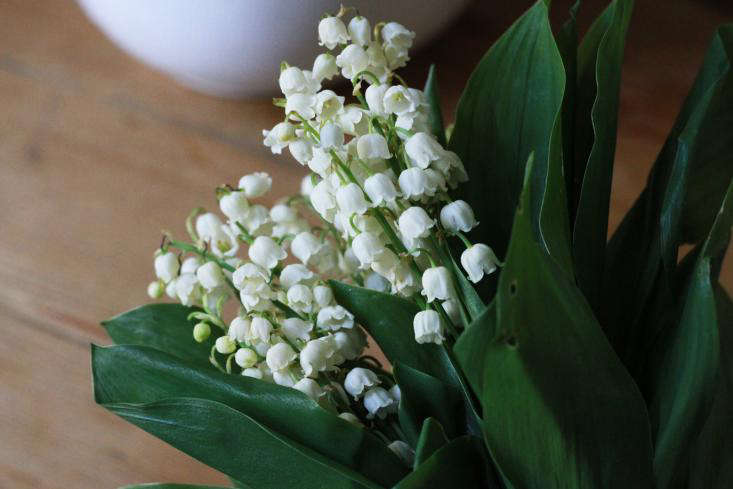To celebrate the first of May, the French exchange small posies of Lily of the Valley. The delicate stems usually aren’t ready for plucking on May 1 in New York, but that doesn’t mean we shouldn’t make posies to give away when they finally do bloom. Here’s my take on the traditional posy:
If you’re not lucky enough to have Lily of the Valley growing in your own yard, you might experience a bit of sticker shock at the florist shop. Many florists only carry stems on special order and when they do, they can be upwards of $20 a stem. For these posies, I trekked to the flower market in Manhattan, where they were selling tiny bunches of ten stems for $11.50 each. Still pricey, but much more affordable than a special order.
(If you’d like to plant your own pot of Lily of the Valley, a kit with 12 pips plus potting soil is $45 from White Flower Farm.)
Despite the price, if it’s something delicate and fragrant that you’re after Lily of the Valley is the secret. If you have a spot of land (or a windowsill) and can get your hands on a few pips, plant them now. For instructions, see How to Force Lily of the Valley Indoors.

Stems at the flower market were sold in bunches alongside their leaves. The naked stems seem lonely to me, so I incorporated the leaves into my posies.
For an accompaniment that’s every bit as dainty and just a fraction of the cost, I chose small bunches of field-grown daffodils that I bought at the Union Square Farmers Market. Farmers coming into the city from upstate still have late-blooming daffodils like the tiny Pheasant’s Eye by the cart full.
If you’re thinking ahead to next year, you can order Pheasant’s Eye Daffodil bulbs for fall shipment; they’re $21.75 for 25 bulbs from Brent and Becky’s Bulbs.

The stems of Lily of the Valley are only about 6 inches long. Because of their diminutive size, they can be easily overpowered in a large bouquet, so using just a few other stems is a nice way to showcase the tiny flowers.

In keeping with their role as the understory in the garden, I arranged my Lily of the Valley below the taller daffodil stems; they look at home peeking out of a hiding spot.

I used vintage medicine bottles in a variety of heights to arrange my posies. For a similar look, a three-bottle collection of Glass Antique Medicine Bottles is $28 from My Vintage Soiree via Etsy.

Above: In keeping with the spirit of May Day, you might consider making a whole batch of posies to give as gifts to friends and neighbors. But if you’d rather keep the posies for yourself (and we can see why you would), consider distributing the posies to bedsides and medicine cabinets around your house.
For more about these fragrant flowers, see Would Spring Still Smell Like Spring Without Lily of the Valley?
Finally, get more ideas on how to successfully plant, grow, and care for lily of the valley with our Lily of the Valley: A Field Guide.
Interested in other bulbs and tubers for your garden or indoor space? Get more ideas on how to plant, grow, and care for various bulbs and tubers with our Bulbs & Tubers: A Field Guide.
Finally, get more ideas on how to plant, grow, and care for various perennial plants with our Perennials: A Field Guide.

















Have a Question or Comment About This Post?
Join the conversation (3)